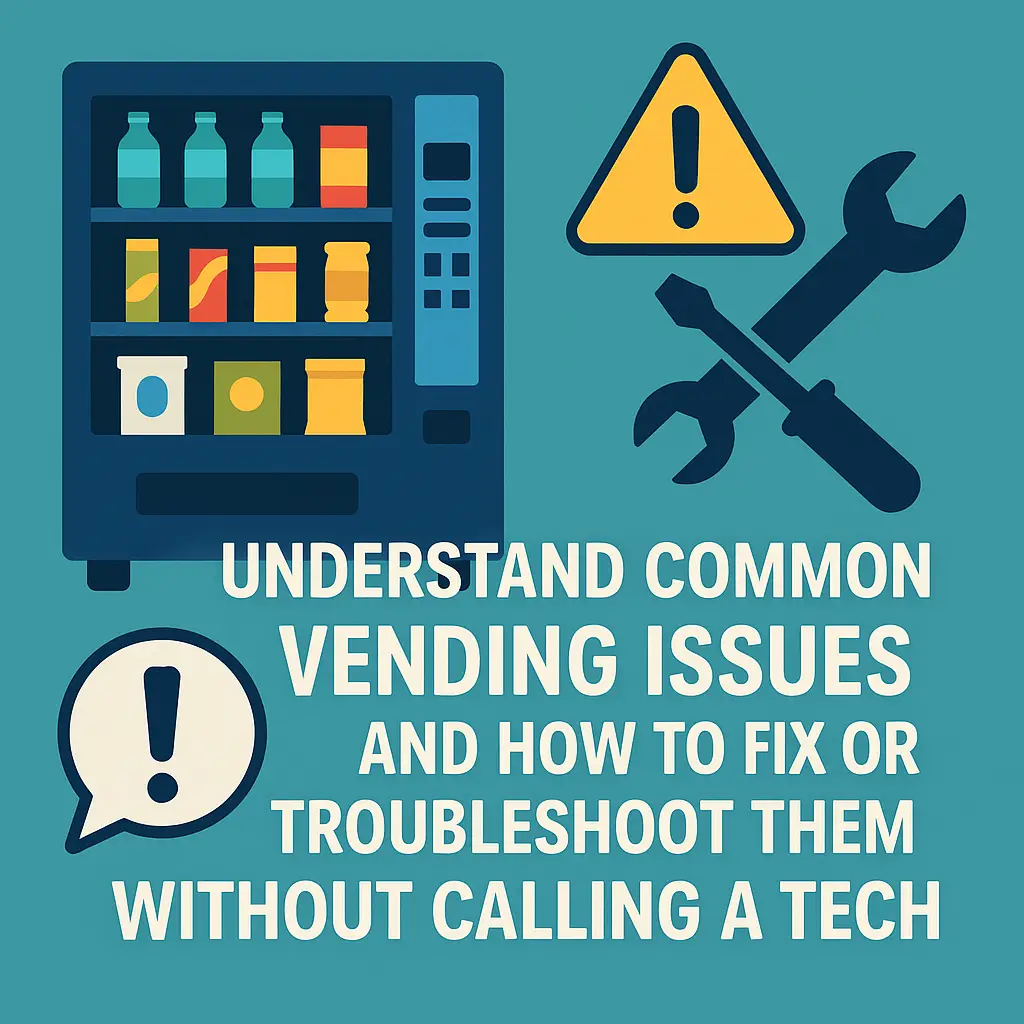Vending Machine Repair Basics
Understand common vending issues and how to fix or troubleshoot them without calling a tech.
Back to Vending Business Startup ResourcesUnderstand common vending issues and how to fix or troubleshoot them without calling a tech.
Back to Vending Business Startup ResourcesStart your 30-day free trial and get instant SMS and email alerts whenever a local business needs vending service. These are real location leads to help you grow your route — you decide which ones to buy, no obligations or contracts.
![]() Bill jams can often be fixed with simple cleaning
Bill jams can often be fixed with simple cleaning
![]() Rebooting fixes many vending tech errors quickly
Rebooting fixes many vending tech errors quickly
![]() Sensor issues cause common dispensing failures
Sensor issues cause common dispensing failures
30 days free, then $39 / month.
No Commitment. Cancel Anytime.

Vending machines are built to be durable, but like all equipment, they occasionally run into issues. Understanding common problems and how to troubleshoot them can prevent service delays and protect your bottom line. Many basic repairs don’t require a technician and can be performed with minimal tools and know-how.
One of the most frequent problems vending operators face is coin or bill jam. If coins or cash aren't registering, check the coin and bill acceptor for debris. Use a soft brush or compressed air to gently clean. Also, make sure the coin path isn’t blocked by misfed coins. Power cycles often reset recognition systems.
Another common issue is when products don’t dispense. Check the spiral arm to ensure it's correctly aligned. If the issue is in a glass-front or combo machine, inspect the drop sensor or delivery bin for blockages. Many modern machines alert operators to jammed motors or stuck coils through diagnostic codes or on-screen messages, so knowing how to read these is key.
Sometimes the digital display might go blank. First, see if the outlet is live by plugging in another device. If it works, unplug the machine and check the fuse or circuit board for physical damage. Rebooting by unplugging the machine for 30 seconds often restores functionality, especially in newer units with embedded software.
For machines not cooling properly, open the back panel and clean the condenser coils. Overheating or dust buildup can prevent adequate refrigeration. Also, ensure the temperature setting hasn’t been accidentally changed.
Most importantly, always keep basic maintenance tools on hand—like wipes, a flashlight, multimeter, and cleaning brushes. Familiarize yourself with the machine’s model manual, which typically includes diagnostic codes and step-by-step repair guidance.
If you're expanding your routes or just starting out, you may also want to review this overview of location exclusivity agreements as well as tips from how locator services work in the vending industry.
Vending Exchange connects vending operators with real businesses actively looking for vending services—including traditional machines, AI coolers, and office coffee. Get instant SMS and email alerts when new opportunities are available in your area. No contracts or monthly fees—just buy the leads you want. Start your free 30-day trial today and grow your vending business on your terms.
This is often due to dirty or misaligned bill validators. Clean the validator with a soft cloth and check for proper alignment. Sometimes the firmware may need updating.
Ensure the machine is plugged into a working outlet, clean dust off the condenser coils, and check refrigeration settings. If the compressor is silent, it may need replacement.
Items stuck in the coil or sensor failures are common causes. Manually test the motor, check for obstructions, and reset the machine to clear errors.
Check the power source and breaker. Inspect internal fuses and wiring. Some machines have internal resets or diagnostic displays near the control board.
Unplug the machine for 30 seconds and plug it back in. For machines with keypads, some models include a reset sequence detailed in the user manual.
Coin jams usually occur due to debris or damaged coins. Open the coin slot path, remove any stuck coins, and clean the mechanism with compressed air.
Use the machine's diagnostic mode if available. Many machines offer motor test functions via the keypad or service switch.
Beeping usually signals an error like a jammed motor, empty coil, or pricing issue. Refer to the error code and manual for specific diagnosis.
Yes. First check the power supply, then inspect connections to the display panel. Replacing a worn control board may be necessary if issues persist.
This may be due to misalignment, product size not matching coil spacing, or delivery bin obstruction. Adjust settings and confirm correct loading technique.